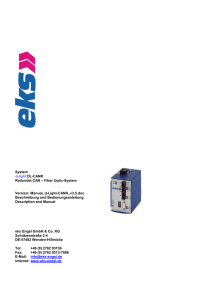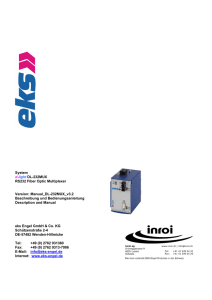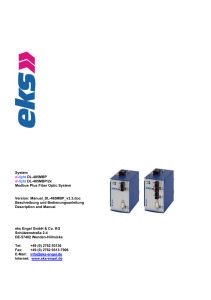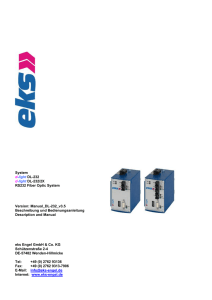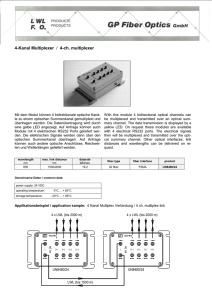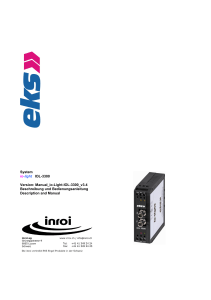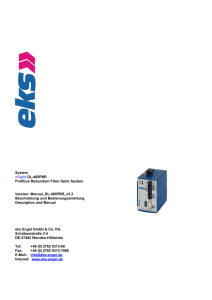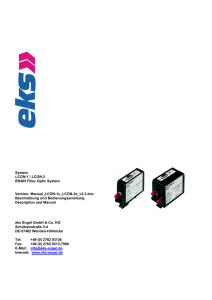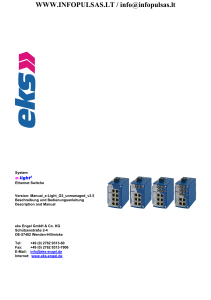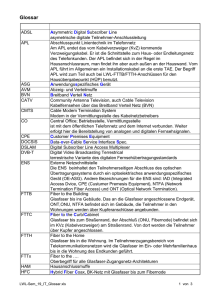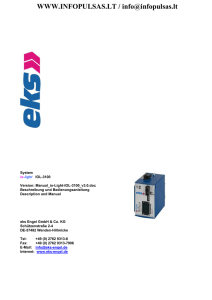System d-light DL-CAN d-light DL-CAN/2x CAN
Werbung
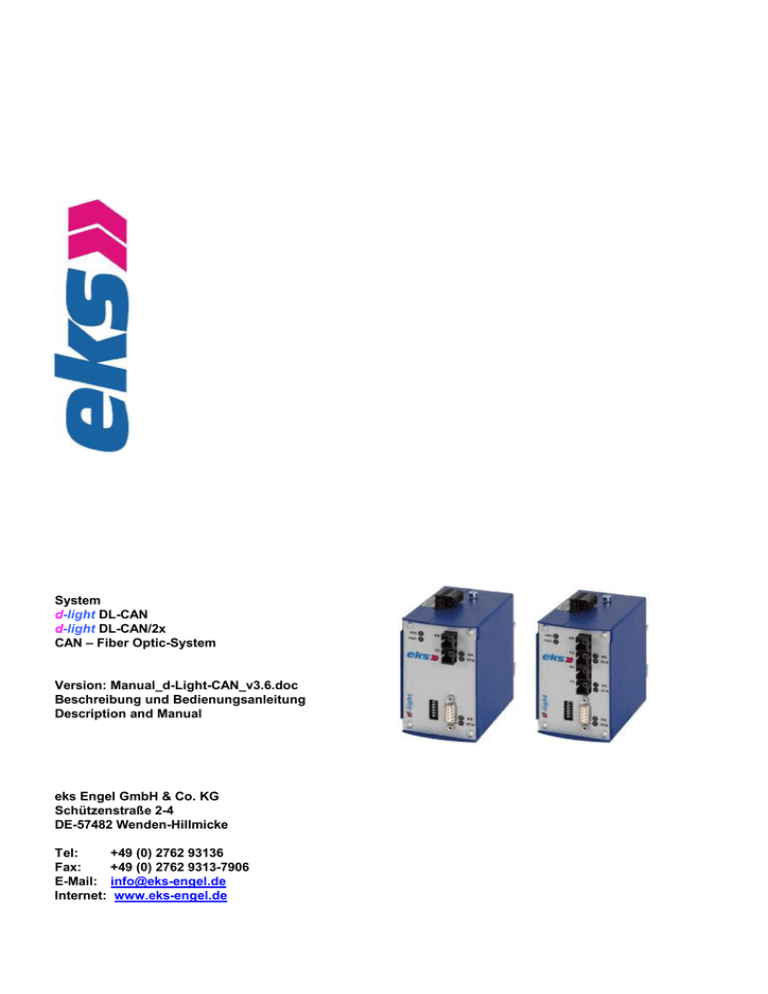
System d-light DL-CAN d-light DL-CAN/2x CAN – Fiber Optic-System Version: Manual_d-Light-CAN_v3.6.doc Beschreibung und Bedienungsanleitung Description and Manual 010007401 010007402 010007421 010007423 010007431 010007433 010007451 010007452 010007483 010007473 010007471 010007481 eks Engel GmbH & Co. KG Schützenstraße 2-4 DE-57482 Wenden-Hillmicke Tel: +49 (0) 2762 93136 Fax: +49 (0) 2762 9313-7906 E-Mail: [email protected] Internet: www.eks-engel.de Bedienungsanleitung d-light DL-CAN Systembeschreibung System Description Die Geräte des Typs d-light DL-CAN dienen zur Verbindung von CANVerbindungen über Lichtwellenleiterstrecken. Sie besitzen zwei Versorgungsspannungseingänge, so dass sie redundant mit Spannung versorgt werden können. Ein integriertes Fehlerrelais kann verwendet werden, um Fehler zur Anzeige zu bringen. Die Systeme d-light DL-CAN/2X ermöglichen den Drop-Betrieb. System d-light DL-CAN allows the connection of CAN networks by using redundant fiber optic systems Als wichtige Leistungsmerkmale gelten die Übertragung mit Kunststofffaser-, HCS, Multimode- oder Singlemode. d-light DL-CAN/2X allows drop-mode transmission. Important performance features of the transfer with POF, HCS, multimode or singlemode fiber optic are the electromagnetic ruggedness, the potential separation of transmitter and receiver, as well as ranges up to 40km between two fiber optic systems. LEDs and potential-free contacts (optional) of a fault detector relay are able to signal defective states. Anschlusshinweise Hardware Installation Achtung: Beim Betrieb elektrischer Betriebsmittel und Anlagen stehen zwangsläufig bestimmte Teile unter gefährlicher Spannung. Arbeiten an elektrischen Anlagen oder Betriebsmitteln dürfen nur von einer Elektrofachkraft oder von unterwiesenen Personen unter Anleitung und Aufsicht einer Elektrofachkraft, den elektrotechnischen Regeln entsprechend, vorgenommen werden. Schalten Sie die Systeme und Endgeräte spannungsfrei. Rasten Sie das Gerät auf eine Tragschiene DIN EN auf, und überprüfen Sie den sicheren Halt! Achtung: Benutzen Sie nur die zugehörigen LWL-Anschlussstecker. Wir weisen ausdrücklich daraufhin, dass der Anschluss mit falschen Steckverbinder Schäden an den optischen Anschlüssen hervorrufen kann! Beachten Sie zudem, dass die Stecker, die eine Verriegelung besitzen, nur in einer definierten Position montiert werden können. Achtung: Sehen Sie nicht in den optischen Sender! Das gebündelte und abhängig von der Wellenlänge sichtbare oder unsichtbare Licht kann zu Augenschäden führen! Verbinden Sie den ankommenden Lichtwellenleiter mit dem optischen Empfänger und den abgehenden LWL mit dem optischen Sender des LWL-System. Benutzen Sie die beigefügten Stopfen um Sender und Empfänger des LWLSystem im nicht eingebauten oder nicht benutzten Zustand vor Verunreinigungen oder Staub zu schützen. Achtung: Knicken Sie das LWL-Kabel nicht zu stark und beachten Sie den Biegeradius des Kabelherstellers. Andernfalls kann das Kabel beschädigt werden und/oder die Kommunikation zwischen den LWL-Wandlern nicht mehr gewährleistet werden. Schalten Sie die Betriebsspannung für die LWL-Systeme ein. Zur Versorgung der Systeme wird eine Betriebsspannung von 24VDC benötigt, die an die Klemmen VDC1 oder VDC2 und GND angelegt wird. VDC1 und VDC2 sind redundante Versorgungsspannungseingänge mit Verpolungsschutz. Funktion des DIP-Switch : DIP-Schalter 1-4 definieren die Datenrate DIP-Schalter 5: Fehlerunterdrückung Kanal 2 bei DL-CAN/2x, bei DL-CAN/1x muß ON aktiviert sein. DIP-Schalter 6 terminiert den Bus (Rw = 120Ohm) WICHTIG: Bitte nach jeder Änderung am DIP-Switch den DL-CAN zurücksetzen (Reset) durch Spannungsabschaltung. Funktion der Status-LED´s: · VDC : +24V Versorgungsspannung liegt an VDC1 oder VDC2 an · FAIL : Sammel-Fehlermeldung und Fehlerrelais geöffnet · Status : LWL: Optisches Empfangssignal fehlerhaft CAN: Bitfehler, Quersummenfehler oder Busfehler. Werden CANDaten im optischen Bus übertragen und ist an einem DLCAN kein CAN-Teilnehmer angeschlossen, so blinkt die Status-LED neben dem SUB-D-Anschluss. · Rx : Empfang von Daten · Fehlerrelais: An Klemmen K1 bis K3 befindet sich ein potentialfreier Fehlerrelaiskontakt; K2 ist der gemeinsame Anschluss des Relais. Sobald beide optische Verbindungen einwandfrei funktionieren und am elektrischen Anschluss kein Busfehler erkannt wird, zieht das Fehlerrelais an (K1-K2 geschlossen und K2-K3 geöffnet). Wird eine der optischen Verbindungen unterbrochen oder wird am elektrischen Anschluss ein zu lange andauernder Nullpegel erkannt, dann wird das Fehlerrelais geöffnet (K1-K2 geöffnet und K2-K3 geschlossen). Ebenso öffnet das Fehlerrelais, wenn an keinem der beiden VDC-Eingängen eine Versorgungsspannung anliegt. Funktion der Kontakte K1 - K2: Fehlerrelaiskontakt: Öffnet im Fehlerfall Funktion der Kontakte K2 – K3: Fehlerrelaiskontakt: Geschlossen im Fehlerfall Initialisierung der Geräte: Nach dem Einschalten der Systeme wird zunächst die verwendete CAN-Datenrate eingestellt und ein LED-Funktionstest für 2 Sekunden durchgeführt. Power off the devices, which will be connected by using the fiber optic system. Snap the system onto the DIN EN rail and check the correct holding! Attention: Only use the correct optical connectors for the fiber optic system. Using incorrect connectors can cause damage to the fiber optic system. Take care that connectors with a latch can only be mounted in a defined position. Attention: Don't stare into the optical cable or the transmitter of the fiber optic system. Visible and non visible light (depending on its wavelength) of the optical transmitter can cause eye-damages! Connect the fiber optic system by using the correct fiber optic cable. Take care that you always have to connect an optical transmitter with an optical receiver. Use the plugs to save the unused optical receiver and transmitter against impurity. Attention: Don't bend the fiber optic cable! Please refer to the manufacturer’s specifications. Otherwise the fiber optic cable can be damaged or the communication is disturbed. Power on the devices. Please use a power supply of 24VDC, connected to the terminals marked with VDC1, VDC 2 ans GND. Note, that VDC 1 and VDC 2 are redundant power inputs with reverse voltage protection. STAND: MANUAL_D-LIGHT-CAN_V5.0.DOC TECHNISCHE ÄNDERUNGEN VORBEHALTEN SUBJECT TO TECHNICAL ALTERATIONS Function of the DIP-Switch : DIP-Switch 1-4 defines the data rate DIP-Switch 5 Alarm suppression at Channel 2 at DL-CAN/2x, must be in position ON for DL-CAN/1x. DIP-Switch 6 enables the CAN termination Bus (Rw = 120Ohm) NOTICE: Please power off (reset) the DL-CAN after each DIP-Switch changing! Function of the Status-LEDs: · VDC : +24V Power Supply at VDC1 or VDC2 · FAIL : Failure group signal and failure relay opened · Status : Fiber: Received optical signal failed CAN: bit failure, check sum error or bus error. Please note, that by transmitting CAN-data in an optical bus structure at a DL-CAN with no electrical connection to SUB-D or screw terminals the red status LED ist flashing. · Rx : Receiving data · Failure Relay:: Terminals K1 to K3 are connected to a potential free relay. If both optical and electrical connections work without failures the relay gets active and closes K1 to K2 and opens K2 to K3. If one of the optical connections is disconnected or the electrical interface detects a too long zero state or power supply at VDC1 or VDC2 fails, the relay will get inactive and K1 to K2 opens and K2 to K3 closes Function of K1 – K2: Potential free failure relay contact NC. Function of K2 – K3: Potential free failure relay contact NO. Initialization: After having powered on the fiber optic systems it tries to detect the data rate. If a data rate is detected, the system starts the data transmission. Large ring structures take a time of several seconds until they detect the data rate and close the ring. The STATUS-LED near the SUB-D connector shows if the system is running. If that LED is flashing, a bus error occurs. SEITE : 1 Bedienungsanleitung d-light DL-CAN Abmessungen / Dimensions 61 mm 61 mm GND Earth VDC2 VDC1 115 mm VDC1 VDC1 FAIL FAI L RX St atu s S tatu s 113 mm RX RX RX RX S tatu s K1 K2 K3 K4 6 5 4 3 2 1 Earth GND CAN L CAN H NC GND St atu s - light - light St atus Anschluss und Abschlusswiderstand / Connectors and Termination Sub-D Schraubklemmen Screw terminals Abschlusswiderstand und Datenrateneinstellung Termination and setting the data rate OFF ON DR4 DR3 DR2 DR1 OFF ON F1 DIP-Schalter 5 (F1): ON: Default für DL-CAN/1x oder Fehlerunterdrückung beim System DL-CAN/2x für den Kanal 2, falls dieser nicht angeschlossen wird. OFF: für zweikanaligen Betrieb. 1000KBaud DR 1 0 DR 2 0 DR 3 0 DR 4 0 800KBaud 1 0 0 0 500KBaud 0 1 0 0 250KBaud 1 1 0 0 125KBaud 0 0 1 0 100KBaud 1 0 1 0 0 Datenrate 50KBaud 0 1 1 22,2KBaud 1 1 1 0 20KBaud 0 0 0 1 10KBaud 1 0 0 1 OFF ON RW DIP-Switch 5 (F1): ON: Default for DL-CAN/1x or suppresses the failure alarm at DL-CAN/2x in case of disuse fiber channel 2 OFF: operates with two FX channels Bitte nach jeder Änderung am DIP-Schalter den DL-CAN zurücksetzen (RESET)! Please power off the DL-CAN after each DIP-switch changing (RESET)! STAND: MANUAL_D-LIGHT-CAN_V5.0.DOC TECHNISCHE ÄNDERUNGEN VORBEHALTEN SUBJECT TO TECHNICAL ALTERATIONS SEITE : 2 Bedienungsanleitung d-light DL-CAN TYPENAUSWAHL / TECHNISCHE DATEN TYPE SELECTION / TECHNICAL DATA Typ 1FX Type 2FX Bestellnummer Order No. Typ 2FX Type 2FX Bestellnummer Order No. LWL-Anschluss Fiber-connector Faser Fiber Optisches Budget Optical budget LWL - Reichweite Transmission path Wellenlänge Wavelength Datenrate Transmission rate Übertragungsart Transmission Abschlusswiderstand Load Anschlusslänge Cable Length DL-CAN/ 1x6-P-ST DL-CAN/ 1x6-P-SM DL-CAN/ 1x13-MM-ST DL-CAN/ 1x13-MM-SC DL-CAN/ 1x13-SM-ST DL-CAN/ 1x13-SM-SC 0 100 07401 0 100 07402 0 100 07421 0 100 07423 0 100 07431 0 100 07433 DL-CAN/ 2x6-P-ST DL-CAN/ 2x6-P-SM DL-CAN/ 2x13-MM-ST DL-CAN/ 2x13-MM-SC DL-CAN/ 2x13-SM-ST DL-CAN/ 2x13-SM-SC 0 100 07451 0 100 07452 0 100 07471 0 100 07473 0 100 07481 0 100 07483 ST SMA ST SC ST SC Multi-Mode 62,5 (50) /125µm Single-Mode 9/125µm 12 dB 13dB 17 dB 50 m 5 km 30 km (180dB/km) (1 dB/km) (0,4 dB/km) 650 nm 1310 nm 1310 nm 1000, 800, 500, 250, 125, 100, 50, 22,2, 20 und 10 KBaud über DIP-Schalter einstellbar 1000, 800, 500, 250, 125, 100, 50, 22,2, 20 und 10 KBaud by DIP-Switch settings Halbduplex / halfduplex schaltbar: offen oder Wellenwiderstand (Rw) switchable termination: open or characteristic impedance (Rw) Gemäß CAN-Spezifikationen Cable Length according to CAN-specification 9-polige Sub-D-Buchse und 6-polige Anschlussklemme 9-pin female Sub-D and 6-pin connectiong terminal Anschlussstecker Connector Status - LEDs Control - LEDs Betriebsspannung Operating voltage Stromaufnahme Current consumption Potentialtrennung Potential separation Betriebstemperatur Operating temperature Lagertemperatur Storage temperature EMV EMC POF 980/1000µm Stromversorgung (grün) / Datenempfang (gelb) / Status(rot) power supply (green) / data receive (yellow) / status (red) 12-30 DC, andere Spannungen auf Anfrage other voltages on request 200 mA 500 VDC (24 VDC ® CAN) -10°C - +55° C -40 - +85° C EN61000-6-2 (2001) / EN55022 Kl. B (1998) +A1 + A2 Voraussetzung für die Konformität ist die Verwendung eines geschirmten CAN-Kabels und ordnungsgemäße Erdung der Systeme Gewicht Weight Maße H x T x B Dimensions H x D x W Gehäuse Case STAND: MANUAL_D-LIGHT-CAN_V5.0.DOC TECHNISCHE ÄNDERUNGEN VORBEHALTEN SUBJECT TO TECHNICAL ALTERATIONS 500 g H: 115mm B: 61mm T: 113mm H: 115mm W: 61mm D: 113mm Edelstahl, pulverbeschichtet Stainless steel, powder-coated SEITE : 3
